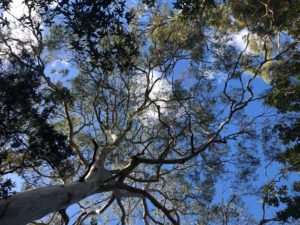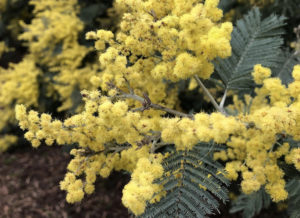Ruth Dawkins considers the blocks, loops and parallels of teenaged dog-walks in the Scottish Borders and in adulthood in Tasmania.

As a teenager growing up in the Scottish Borders, I took the same route to walk our two dogs each day after school. My family referred to it as ‘the block’.
“I’m just heading out round the block,” I’d call to mum, if she was busy painting or preparing something for dinner. Sometimes, she would come too, and we’d have a chance to catch up on the day’s news.
The block was a loop of about four kilometres, or two and a half miles, and we always walked it clockwise; a narrow, single lane road, flanked by tall hedges and stone walls, with farmland stretching away on either side.
Every so often now, I search for it on Google Street View. Mum doesn’t live there anymore, and I haven’t been back in more than 20 years. It doesn’t look like the roads have been touched in that time. They’re even more potholed than they used to be, and on some stretches the grass is growing right up through the tarmac. But the views are the same, and although the Street View version is trapped in August, it prompts me to remember how that daily walk changed through the seasons.
The flat images on my screen spark memories of the constant noise of combines and grain dryers at harvest time, of pheasants strutting along the verge, and of the pin prick thorns of sloes and brambles that I’d always have to pull from the backs of my hands. I am reminded of hares and foxes, hawks overhead, and the strange, asymmetrical silhouette of Hume Castle in the distance.
One winter in the mid 1990s, it snowed so heavily in the Borders that the block was unpassable for weeks. With the whole region covered in snow and ice, schools were closed and helicopters were brought in to drop supplies to remote villages. We lost power to the farmhouse, and spent the days listening to updates on local radio, boiling water for tea on a camping stove, and toasting bread over the open coal fire in our living room.
Mum and I layered up and walked where we could amid the six-foot drifts. We criss-crossed fields that were usually off limits, and admired the thick, curling icicles that trembled on wire fences. Eventually the plough showed up and pushed the great white mounds to the edges of the road, bringing life — and dog walks — back to some kind of normal.
I walked that block so often, and for so long, that I could probably manage it even now with my eyes closed. Like other places remembered from childhood though, I suspect it would seem somehow smaller.
*
As an adult, now living in lutruwita/Tasmania, I have my own version of the block — another loop that I walk at least once each day.
The entrance to Lambert Reserve is a few hundred metres from our front door. To access it, you cross the top end of a sports oval and walk up a gravel path beside a senior citizens’ club. The reserve is just a couple of square kilometres; a long, thin patch of land that feels slightly squeezed by busy roads on all sides. And yet, once you start walking, there is no sense of being in a city.
There is a rivulet that runs through the steep-sided gully at its lowest point; a lower, upper and middle path; and a couple of small bridges. On wet days, the tree canopy gives some protection from the rain. On hot days it gives shade, far cooler than the surrounding streets and pavements.
When I first moved to nipaluna/Hobart from the UK with my family, we barely went in there. It was exactly the kind of place I imagined to be full of venomous snakes, and thick, silky spider webs spun across the paths.
After a few years, when I had calmed down and realised that lutruwita/Tasmania wasn’t actually trying to kill me, I started to poke around in the reserve more regularly. My son and I would zip along the lower path on our bikes, until we reached a steep hill that felt like too much effort and turned back. Often, we would cut through one corner of the reserve on our morning walk to school.
But it wasn’t until the first covid lockdown in April 2020 that we started to walk those tiny trails on a weekly basis, and it was when we got a dog more than a year later that the place became somewhere we went back to again and again. Now the block — or the loop — is always one of our three daily walks.
Because the reserve is so tiny, I notice everything, and am slowly starting to learn what changes to expect: when I’ll encounter the heady scent of gum nuts scattered on the ground, and when the explosion of golden wattle will bring joy and sneezes. I listen for the dry crackle of eucalyptus bark peeling off trunks, and keep a keen watch for the tiny nubs of white fungus that sprout on fallen logs before growing long and flat until they look like piano keys.

I could not love it more. I love the teeny-tiny purple flowers, smaller than my pinky nail, that pop up in spring. The moss that’s so vibrantly green it looks synthetic. The mama ducks floating silently in the shallows, and the heady squawk of cockatoos that tell me rain is on the way.
I love the glimpses of kunanyi/Mount Wellington that you catch through the trees — the white-capped summit as close as I get to snow these days. I love the ever-changing light, the delicate lichen, and the gnarly old-tree trunk that looks like the rabbit from Donnie Darko. I love the birds: the magpies and fairy wrens, the galahs and rosellas, the kookaburras and goldfinches and currawongs. There’s a whole family of Black currawongs in there at the moment; they sit motionless and watch as we walk by, the atmosphere fizzing with their quiet energy.
If there are snakes — and there are bound to be — we are yet to see them. My son once came home from school, wondering out loud if he’d walked past one with its head stuck in a plastic bag, but we later found out it was a blue tongued lizard in the middle of shedding its skin. Still, in the hot summer months, I keep a watchful eye on the sticks and bark strips that litter the paths, and we always wear closed-toed shoes.
This summer, there has been a little pademelon living in there. Tiny wallabies with bright eyes, pademelons look so delicate, and yet the thud of the dry ground when they bounce away on those big feet is unexpectedly loud. On this morning’s walk, we startled it sipping water from the rivulet, and it bounded up the other side of the bank away from us, but then stopped to peer out from behind a bush, watching to see if we would follow.
There is human life in the reserve too. Countless dog walkers like us, who sometimes have to squeeze awkwardly past each other on the narrow stone steps at the western end of the reserve. Slackliners who string their ropes between trees, and leave them dangling when they’re not in use. Students from nearby schools, who gather at the end of the day to exchange news and often rival the cockies for volume. Twitchers, on occasion, binoculars and cameras pressed to their faces as they look for something new to add to their life list.
I feel like even if I live here my whole life, I will not know all there is to know about the reserve. Even with countless bird song and plant ID apps on my phone, I’m so aware of how much there is still to learn about this tiny patch of land. A few weeks ago, I saw a woman walk out of there with armfuls of flowers. Convinced she was stealing the rare orchids that grow a few metres from the path, less convinced about the rules around doing so, I messaged a botanist friend on Twitter with a picture of what I’d seen her carrying.
‘No worries,’ she responded, ‘just freesias, they’ve probably escaped from a nearby garden. Help yourself.’
I replied that I likely wouldn’t help myself, but I would at least stop giving other people stink eye when they did.
Next time I went for a walk, I spotted a garden at one of the entrances to the reserve that was full of yellow, white and pale purple freesias.
*
This is an obvious thing to state, but every dog walk I have ever been on has started and ended at home.
When I do my virtual walk of the original block in Google Street View, I come up the final hill on approach to the farmhouse and narrow my eyes as I search for…what? A ghost version of myself?
I find her in the basketball hoop, still surprisingly bright, that is attached to the garage wall. In the fully landscaped duck pond that I know started as runoff from all that snow in the 90s. In the sturdy tree that is just visible in the field beyond.
(I used to climb up the bare trunk, and would sometimes get stuck for hours, intimidated by the herd of cows that used to gather around the base. The cows are now gone, and someone has built an impressive-looking treehouse with a ladder.)
I wonder if my son will do the same thing in future. Will he try and excavate digital layers to discover signs of some past self, some evidence of his existence? The tracks and trails of Lambert Reserve are safe (for now) from the prying lens of the catch-all camera. But will he search our address and find the hedge a little taller, the fence painted a different shade of grey?
When he and I were on our way home from a dog walk late last year, we caught sight of the Google Street View car driving up and down our road. The car, of course, caught sight of us too. So now we are there, captured forever, a few hundred metres from home. My son is turning to look as the car drives past us. I have one arm raised in a wave. The dog is straining at the end of her lead, unsure why we have stopped.
*
Ruth Dawkins is a freelance writer who has written for the Guardian, Washington Post and Time Out. Find her blog here, and follow her on Twitter here. Read a piece previously published on Caught by the River, about returning to her childhood home on the Isle of Harris, here.